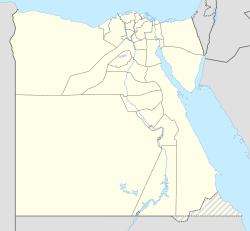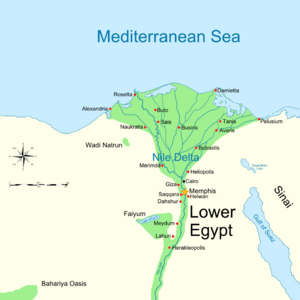Bubastis facts for kids
|
Ⲡⲟⲩⲃⲁⲥϯ
تل بسطة |
|
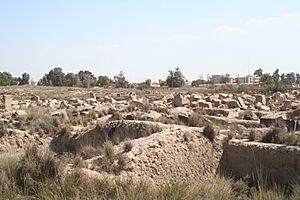
View of Bubastis
|
|
| Alternative name |
|
|---|---|
| Location | Tell-Basta, Sharqia Governorate, Egypt |
| Region | Lower Egypt |
| Coordinates | 30°34′22″N 31°30′36″E / 30.57278°N 31.51000°E |
| Type | Settlement |
| Site notes | |
| Condition | In ruins |
Bubastis was an ancient Egyptian city. It was also known as Tell-Basta in Arabic and Per-Bast in ancient Egyptian. Some people think it might be the same city as Pi-Beseth mentioned in the Bible.
Bubastis was the capital city of its own region, called a nome. It was located along the River Nile in the Nile Delta area of Lower Egypt. The city was very important as a place of worship for the cat goddess Bastet. Because of this, it was the main place in Egypt where mummified cats were buried.
Today, the ruins of Bubastis can be found near the modern city of Zagazig.
Contents
What Does the Name Bubastis Mean?
The Egyptian name for Bubastis was Pr-Bȝst.t. This name is usually pronounced Per-Bast. It means "House of Bast". The name comes from two Egyptian words: pr meaning "house" and the name of the goddess Bastet.
Over time, the way people spoke Egyptian changed. So, the pronunciation of the city's name also changed.
A Look at Bubastis Through Time
Bubastis was the capital of the Am-Khent nome. This was the 18th nome in Lower Egypt. The city was located southwest of Tanis, on the eastern side of a branch of the Nile River.
Early History: Second Dynasty Events
A long time ago, a Greek historian named Manetho wrote about Bubastis. He said that during the rule of Hotepsekhemwy, a "chasm opened near Bubastis". Many people were lost during this event. This happened during Egypt's Second Dynasty.
Middle Kingdom: Twelfth Dynasty Palace
During the Middle Kingdom, Bubastis had a huge palace made of mudbricks. This palace was built during the Twelfth Dynasty. It was thought to be a home for Amenemhat III, an important pharaoh. A stone carving found there shows the king celebrating a special festival.
Later Periods: Rise and Fall
Bubastis became a royal city around 943 BC. This was when Shoshenq I became pharaoh. He was the first ruler of the 22nd Dynasty. The city was at its most powerful during the 22nd and 23rd Dynasties.
However, Bubastis began to decline after 525 BC. This was when Cambyses II of Persia conquered Egypt. The Persian conquest marked the end of the 26th Dynasty.
During the 22nd Dynasty, Bubastis was one of the most important cities in the Nile Delta. South of Bubastis, there were lands given to Greek soldiers. These soldiers were from Ionia and Caria. North of the city, a canal was started. Pharaoh Necho II wanted to connect the Nile and the Red Sea. He never finished building it.
Persian Rule and Decline
After the Persians took Bubastis, they tore down its walls. From then on, the city slowly became less important. Even so, it was still mentioned in church records. Coins from Bubastis were even made during the time of the Roman emperor Hadrian.
The Greek historian Herodotus described Bubastis after the Persian invasion. He said:
Temples there are more spacious and costlier than that of Bubastis, but none so pleasant to behold. It is after the following fashion. Except at the entrance, it is surrounded by water: for two canals branch off from the river, and run as far as the entrance to the temple: yet neither canal mingles with the other, but one runs on this side, and the other on that. Each canal is a hundred feet wide, and its banks are lined with trees. The propylaea are sixty feet in height, and are adorned with sculptures (probably intaglios in relief) nine feet high, and of excellent workmanship. The Temple being in the middle of the city is looked down upon from all sides as you walk around; and this comes from the city having been raised, whereas the temple itself has not been moved, but remains in its original place. Quite round the temple there goes a wall, adorned with sculptures. Within the inclosure is a grove of fair tall trees, planted around a large building in which is the effigy (of Bast). The form of that temple is square, each side being a stadium in length. In a line with the entrance is a road built of stone about three stadia long, leading eastwards through the public market. The road is about 400 feet (120 m) broad, and is flanked by exceeding tall trees. It leads to the temple of Hermes.
Religion and the Cat Goddess Bastet
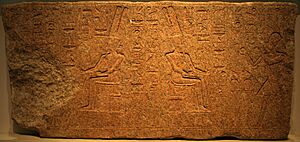
Bubastis was a major center for worshipping the goddess Bastet. She was sometimes called Bubastis after the city itself. The ancient Greeks thought she was similar to their goddess Artemis.
The cat was a very special animal to Bastet. She was often shown with the head of a cat or a lioness. She also appeared with the god Ptah in many carvings. Because of this, the tombs in Bubastis were the main place in Egypt where mummified cats were buried.
The most important parts of Bubastis were its oracle of Bastet. An oracle was a place where people believed they could get advice from a god. The city also had a beautiful temple dedicated to the goddess. There was also an annual parade in her honor. The oracle became very popular when more Greek settlers came to the Nile Delta. This was because the Greeks connected Bastet with their own goddess Artemis. This attracted both Egyptians and foreigners to her shrine.
The festival of Bubastis was thought to be the happiest and most amazing festival in Egypt. Herodotus described it like this:
Barges and river craft of every description, filled with men and women, floated leisurely down the Nile. The men played on pipes of lotus. the women on cymbals and tambourines, and such as had no instruments accompanied the music with clapping of hands and dances, and other joyous gestures. Thus did they while on the river: but when they came to a town on its banks, the barges were made fast, and the pilgrims disembarked, and the women sang, playfully mocked the women of that town and threw their clothes over their head. When they reached Bubastis, then held they a wondrously solemn feast: and more wine of the grape was drank in those days than in all the rest of the year. Such was the manner of this festival: and, it is said, that as many as seven hundred thousand pilgrims have been known to celebrate the Feast of Bast at the same time.
Christian Leaders in Bubastis
Old documents mention three Christian bishops from Bubastis. They lived in the 4th and 5th centuries:
- Harpocration: He was one of the bishops chosen in 325 AD.
- Hermon: He lived around 362 AD.
- Iulianus: He attended an important church meeting in 449 AD.
Discoveries at Bubastis
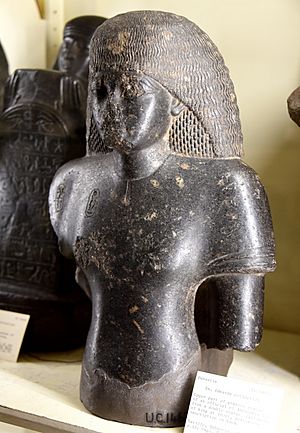
In December 1964, a tomb was found in Bubastis. It belonged to a powerful official named Iuty. He was a vizier during the New Kingdom. The tomb was found in an area called the "Cemetery of the Nobles."
Since 2008, a team from Germany and Egypt has been digging at Bubastis. They are part of the "Tell Basta Project." Before that, in March 2004, a well-preserved copy of the Decree of Canopus was found in the city. This was an important ancient Egyptian stone tablet.
Images for kids
-
Hathor capital from the Temple of Bubastis, now in the British Museum.
See also
 In Spanish: Bubastis para niños
In Spanish: Bubastis para niños


